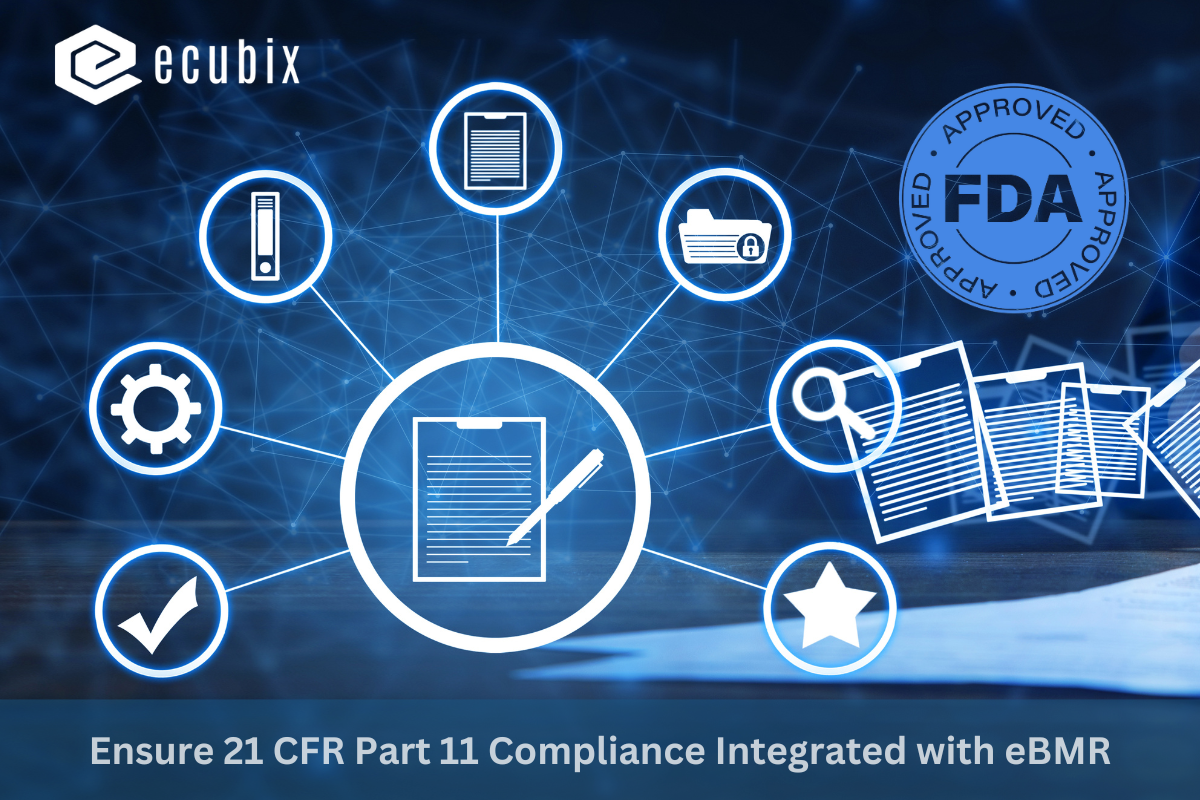21 CFR Part 11 is a section of the Code of Federal Regulations established by the U.S. Food and Drug Administration (FDA). It specifically addresses the use of electronic records and electronic signatures in regulated industries such as pharmaceuticals, biotechnology, and medical devices. Enacted in 1997, this regulation ensures that electronic records and signatures are as trustworthy, reliable, and generally equivalent to paper records and handwritten signatures.
The importance of 21 CFR Part 11 has grown significantly with the increasing reliance on electronic systems in the life sciences industry. According to a 2022 report by the International Data Corporation (IDC), the global market for electronic laboratory notebooks (ELNs) and other laboratory informatics solutions is expected to grow at a compound annual growth rate (CAGR) of 7.9% from 2021 to 2026. This trend underscores the need for robust regulations to prevent data tampering, ensure data accuracy, and safeguard patient safety. Compliance with 21 CFR Part 11 is crucial for companies to avoid regulatory penalties, ensure data validity, and maintain public trust.
Key Requirements and Regulations of 21 CFR Part 11

21 CFR Part 11 outlines specific requirements and regulations to achieve compliance. These can be broadly categorized into three main areas:
(1) Electronic Records:
- Validation: Systems used to create, modify, maintain, or transmit electronic records must be validated to ensure accuracy, reliability, consistent intended performance, and the ability to discern invalid or altered records. A 2023 survey by the Parenteral Drug Association (PDA) found that 85% of pharmaceutical companies prioritize validation as a key component of their compliance strategy.
- Audit Trails: Secure, computer-generated, time-stamped audit trails must be used to independently record the date and time of operator entries and actions that create, modify, or delete electronic records. This requirement ensures transparency and traceability of data changes.
- Record Retention: Electronic records must be maintained in a manner that allows for their accurate and ready retrieval throughout the records retention period. The FDA mandates that records must be retained for as long as they are required to meet regulatory requirements.
(2) Electronic Signatures:
- Uniqueness: Electronic signatures must be unique to each individual and should not be reused or reassigned to anyone else. This requirement is crucial for accountability and traceability.
- Identity Verification: Measures must be in place to ensure that an electronic signature is attributable to the individual who signed the record. This includes requiring at least two distinct identification components such as an identification code and password.
- Non-Repudiation: Electronic signatures must be designed to prevent repudiation of the signed electronic records, ensuring that signatories cannot deny their involvement with the signed records.
(3) General Controls:
- Security and Integrity: Access to electronic records must be limited to authorized individuals. Controls must be in place to ensure the security and integrity of the records, such as password policies, encryption, and user access controls. A 2022 report by Cybersecurity Ventures predicts that global spending on cybersecurity will exceed $1 trillion cumulatively from 2017 to 2025, highlighting the importance of securing electronic records.
- Personnel Training: Individuals who develop, maintain, or use electronic records and signatures must have the education, training, and experience to perform their assigned tasks.
- Policies and Procedures: Organizations must have written policies and procedures to ensure compliance with 21 CFR Part 11 requirements, including documentation of system operations and maintenance.
Integrating 21 CFR Part 11 Compliance with Electronic Batch Manufacturing Record
Designing an Electronic Batch Manufacturing Record (eBMR) system that complies with 21 CFR Part 11 involves several critical steps:
(1) Requirement Analysis: Understand the regulatory requirements and map them to system capabilities. This includes ensuring that the system supports electronic records, electronic signatures, and audit trails.
(2) User Requirements Specification (URS): Define the specific requirements for the electronic batch manufacturing record (eBMR) system, including data capture, processing, storage, and retrieval functionalities.
(3) System Architecture: Develop a robust system architecture that ensures data integrity, security, and availability. This includes choosing the right hardware, software, and network configurations.
(4) Software Selection: Choose software that is designed to comply with 21 CFR Part 11. The software should support electronic signatures, audit trails, and have mechanisms for data integrity.
(5) Access Controls: Implement role-based access controls to ensure that only authorized personnel can access, modify, or approve electronic records.
(6) Audit Trails: Ensure the system generates secure, computer-generated, time-stamped audit trails that independently record the date and time of operator entries and actions.
Validation Processes and Documentation
Validation is a crucial step to demonstrate that the electronic batch manufacturing record (eBMR) system performs as intended and complies with regulatory requirements. The validation process typically involves:
(1) Validation Plan: Develop a comprehensive validation plan outlining the scope, approach, resources, and schedule for the validation activities.
(2) Installation Qualification (IQ): Verify that the system and its components are installed correctly according to the manufacturer’s specifications.
(3) Operational Qualification (OQ): Test the system to ensure it operates according to the defined requirements under normal operating conditions.
(4) Performance Qualification (PQ): Verify that the system performs consistently and accurately under real-world conditions.
(5) Risk Assessment: Conduct a risk assessment to identify potential risks to data integrity and implement appropriate mitigation strategies.
(6) Validation Report: Document all validation activities and results in a validation report, providing evidence that the system is compliant with 21 CFR Part 11.
Ensure To Maintain Data Integrity
Maintaining data integrity is essential for ensuring the accuracy, reliability, and consistency of electronic records. Strategies to maintain data integrity include:
(1) Data Accuracy: Implement data entry controls such as input masks, drop-down menus, and validation checks to minimize data entry errors.
(2) Data Consistency: Use automated workflows to ensure consistent data processing and reduce the risk of human error.
(3) Data Security: Implement encryption for data at rest and in transit to protect against unauthorized access and tampering.
(4) Data Backup: Regularly back up data to secure locations to prevent data loss and ensure data recovery in case of system failure.
Implementing Secure Access Controls

Secure access controls are critical for protecting electronic records and ensuring that only authorized personnel can access and modify them. Key access control measures include:
(1) User Authentication: Implement strong authentication methods, such as multi-factor authentication (MFA), to verify user identities.
(2) Role-Based Access Control (RBAC): Assign access permissions based on user roles and responsibilities, ensuring that users can only access the data and functions necessary for their tasks.
(3) Audit Logs: Maintain detailed logs of user activities, including login attempts, data access, and modifications, to detect and investigate unauthorized activities.
(4) Regular Audits: Conduct regular audits of access controls and user activities to ensure compliance with security policies and regulatory requirements.
Utilizing Electronic Signatures in Electronic Batch Manufacturing Record
Electronic signatures are a key component of 21 CFR Part 11 compliance. To utilize electronic signatures effectively in electronic batch manufacturing record (eBMR):
(1) Signature Uniqueness: Ensure that each electronic signature is unique to an individual and cannot be reused or reassigned.
(2) Signature Binding: Link electronic signatures to their respective electronic records in a manner that prevents them from being removed, copied, or altered.
(3) Identity Verification: Implement robust identity verification methods to confirm the identity of individuals signing electronic records.
Ensuring Proper Record Keeping and Audit Trails
Proper record keeping and audit trails are essential for compliance with 21 CFR Part 11. Steps to ensure this include:
(1) Complete and Accurate Records: Maintain comprehensive and accurate records of all manufacturing processes, including batch records, electronic signatures, and audit trails.
(2) Audit Trail Generation: Ensure that the electronic batch manufacturing record (eBMR) system generates secure, time-stamped audit trails that record all actions related to electronic records, including creation, modification, and deletion.
(3) Audit Trail Review: Regularly review audit trails to detect and investigate any unauthorized or suspicious activities.
(4) Record Retention: Retain electronic records and audit trails for the required period specified by regulatory authorities, ensuring they are accessible and retrievable throughout their retention period.
Case Study 1: Sun Pharmaceutical Industries Ltd.
Company Background: Sun Pharmaceutical Industries Ltd. is one of the largest pharmaceutical companies in India, specializing in a wide range of pharmaceutical formulations and APIs.
Implementation of Electronic Batch Manufacturing Record (eBMR): Sun Pharma implemented an electronic batch manufacturing record (eBMR) system to enhance its manufacturing process efficiency and ensure compliance with global regulatory standards, including 21 CFR Part 11.
Challenges:
- Transitioning from paper-based records to electronic systems.
- Ensuring system validation and data integrity.
- Training personnel to adapt to the new system.
Solutions:
- System Design: Sun Pharma designed a robust electronic batch manufacturing record (eBMR) system with features like real-time data capture, automated workflow management, and secure audit trails. The system was designed to comply with 21 CFR Part 11 requirements from the ground up. Let’s get rid of your batch manufacturing problems once and for all by using eBMR.
- Validation: A rigorous validation process was undertaken to ensure the electronic batch manufacturing record (eBMR) system’s compliance with regulatory standards. This included thorough documentation and testing at each stage of implementation.
- Training: Comprehensive training programs were developed to help employees transition smoothly to the new system. Regular refresher courses were also conducted to maintain high compliance levels.
Results:
- Significant reduction in documentation errors and discrepancies.
- Enhanced regulatory compliance and faster approval processes.
- Improved operational efficiency and reduced cycle times.
Case Study 2: Cipla Ltd.
Company Background: Cipla Ltd. is a renowned Indian multinational pharmaceutical and biotechnology company. It manufactures medicines to treat various medical conditions, including cardiovascular disease, arthritis, diabetes, weight control, and depression.
Implementation of Electronic Batch Manufacturing Record (eBMR): Cipla implemented an electronic batch manufacturing record system to modernize its manufacturing processes and ensure compliance with international regulatory requirements, including 21 CFR Part 11.
Challenges:
- Integrating electronic batch manufacturing record (eBMR) with legacy systems.
- Maintaining data integrity and ensuring robust audit trails.
- Ensuring user acceptance and proper training.
Solutions:
- System Integration: Cipla integrated the electronic batch manufacturing record (eBMR) system with existing enterprise resource planning (ERP) and MES systems to ensure a seamless transition and real-time data synchronization.
- Data Integrity: The electronic batch manufacturing record (eBMR) system included stringent data integrity measures, such as access controls, secure electronic signatures, and automated audit trails.
- User Training: Extensive user training programs were conducted to familiarize staff with the new system, emphasizing the importance of compliance and data integrity.
Results:
- Enhanced accuracy and reliability of batch records.
- Improved compliance with 21 CFR Part 11 and other international regulations.
- Streamlined manufacturing processes and increased productivity.
These case studies highlight how Indian pharmaceutical companies have successfully implemented electronic batch manufacturing record (eBMR) systems to enhance regulatory compliance, improve data integrity, and increase operational efficiency. By integrating 21 CFR Part 11 requirements into their electronic batch manufacturing record systems, these companies have achieved significant improvements in their manufacturing processes and overall business performance.











